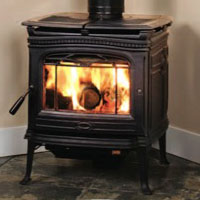 With the high price of home heating fuels and the often sketchy availability of Oil or Natural Gas in the Dead of Winter many home owners are looking to Fireplaces and Wood Burning Stoves as a Primary or Secondary Method of heating their home.
With the high price of home heating fuels and the often sketchy availability of Oil or Natural Gas in the Dead of Winter many home owners are looking to Fireplaces and Wood Burning Stoves as a Primary or Secondary Method of heating their home.
In this How To we will look at the option of using a Wood Burning Stove for Secondary or Backup Heating in Emergency situations.
There are many concerns when adding a wood burning stove to your home and most of them center around safety and fuel availability. If you live in a part of the country where wood is abundant an you can either harvest your own or purchase wood fuel cheaply the cost of running a wood burning stove may approximate or come in less than conventional gas heating and most likely will beat fuel oil costs on an average year. However heating with wood is not a simple task. It requires constant maintenance and a long term commitment in preparation.
It is suggested that wood that will be burnt for fuel be cut and split then set up for two full years prior to burning to remove as much moisture as possible. This is called seasoning your wood and if you were to burn green or unseasoned wood in your fireplace you will increase the possibility of a flue fire due to creosote buildup. It is also suggested that you stick to hardwoods such as oak as they do not have the same resin levels as pine and will burn better.
Most people that order wood from a supplier will purchase seasoned wood however it may only have been seasoned one year. For this reason it is best to store the next years wood separate from the current season and always work with a full year backup if you can. This is not always possible because the amount of wood needed to heat the average home can take up quite a bit of space. Using between 2 and 5 cords of wood a season is pretty common with the average being about three for most of the country. One cord of wood is four feet high x four feet wide x eight feet long and stacked as tightly as reasonably possible. A full year of wood would take up the space along the side wall of an average home which is about 30 feet long.
For these reasons and the problem of disposal of ash the ability for most people to completely heat their home with wood requires a good amount of planning and space not to mention up front cost. It also requires a lot of time.
Using Wood Stoves for Supplemental Heating
 Although using wood for primary heating can be very cumbersome the use of it as supplemental heating is much less of a burden. Because you can not rely on your stove to run unmaintained and shouldn’t really have it lit while you are out of the home it is easy enough to run your Gas or Oil Furnace during those times and then supplement your heating while you are home.
Although using wood for primary heating can be very cumbersome the use of it as supplemental heating is much less of a burden. Because you can not rely on your stove to run unmaintained and shouldn’t really have it lit while you are out of the home it is easy enough to run your Gas or Oil Furnace during those times and then supplement your heating while you are home.
One cord of hardwood will cost you anywhere from $150 to $300 depending on the quality and your area. For most homes under 2,000 square feet this will amount to one to three months of gas heating. If you are able to offset your costs of running your gas furnace by picking up wood for free to nothing then you have saved yourself a good portion of your yearly heating bill.
The more work you can do on your own finding wood the lower your overall cost. Finding a Cord or maybe two of wood is not the hardest thing in the world but finding and preparing five cords of wood is labor intensive for any family.
In the worst days of winter lighting a fire in your wood stove will give your heater a rest and in the beginning and end of the season building a small fire in the early evening might mean your heater won’t come on all day if you have good heat gain from your southern facing windows.
For Emergency situations having a source of heat that does not require your utilities to function can be really important. For many of us a backup kerosene heater can get us through a couple days without electric to run a furnace or when temperatures result in low gas pressure.
On the other hand if you are in an extended situation because of a storm you might need a bit more for an extended period.
Final Note
If you live in an area where you have easy access to free wood then the cost of installing a low end wood burning stove is probably a very smart step to take.
Whether you use it for supplemental or primary heating will depend on your ability to perform the work needed to maintain your stove, your wood supply and feed it throughout the day.
In other How Tos we will cover the different types, installing a stove and all of the ancillary requirements to heating your home with a wood stove.
